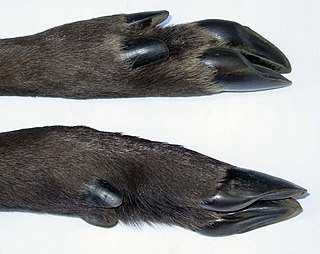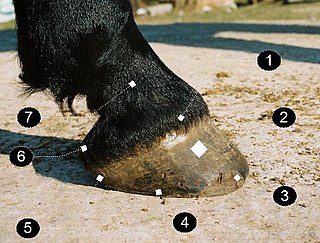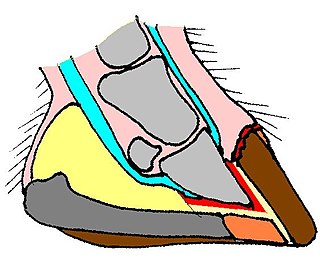Related Research Articles

Horse breeding is reproduction in horses, and particularly the human-directed process of selective breeding of animals, particularly purebred horses of a given breed. Planned matings can be used to produce specifically desired characteristics in domesticated horses. Furthermore, modern breeding management and technologies can increase the rate of conception, a healthy pregnancy, and successful foaling.

Birth is the act or process of bearing or bringing forth offspring, also referred to in technical contexts as parturition. In mammals, the process is initiated by hormones which cause the muscular walls of the uterus to contract, expelling the fetus at a developmental stage when it is ready to feed and breathe.

The plains zebra, also known as the common zebra, is the most common and geographically widespread species of zebra. Its range is fragmented, but spans much of southern and eastern Africa south of the Sahara. Six or seven subspecies have been recognised, including the extinct quagga which was thought to be a separate species. More recent research supports variations in zebra populations being clines rather than subspecies.

The chorion is the outermost fetal membrane around the embryo in mammals, birds and reptiles (amniotes). It develops from an outer fold on the surface of the yolk sac, which lies outside the zona pellucida, known as the vitelline membrane in other animals. In insects it is developed by the follicle cells while the egg is in the ovary.

The hoof is the tip of a toe of an ungulate mammal, which is covered and strengthened with a thick and horny keratin covering. Artiodactyls are even-toed ungulates, species whose feet have an even number of digits, yet the ruminants with two digits, are the most numerous, e.g. giraffe, deer, and bison, cattle, goats, and sheep. The feet of perissodactyl mammals have an odd number of toes, e.g. the horse, the rhinoceros, and the tapir. Hooves are limb structures restricted to placental mammals, which have long pregnancies; however, the marsupial Chaeropus had hooves.

A foal is an equine up to one year old; this term is used mainly for horses, but can be used for donkeys. More specific terms are colt for a male foal and filly for a female foal, and are used until the horse is three or four. When the foal is nursing from its dam (mother), it may also be called a "suckling". After it has been weaned from its dam, it may be called a "weanling". When a mare is pregnant, she is said to be "in foal". When the mare gives birth, she is "foaling", and the impending birth is usually stated as "to foal". A newborn horse is "foaled".

Hemolytic disease of the newborn, also known as hemolytic disease of the fetus and newborn, HDN, HDFN, or erythroblastosis foetalis, is an alloimmune condition that develops in a fetus at or around birth, when the IgG molecules produced by the mother pass through the placenta. Among these antibodies are some which attack antigens on the red blood cells in the fetal circulation, breaking down and destroying the cells. The fetus can develop reticulocytosis and anemia. The intensity of this fetal disease ranges from mild to very severe, and fetal death from heart failure can occur. When the disease is moderate or severe, many erythroblasts are present in the fetal blood, earning these forms of the disease the name erythroblastosis fetalis.

In human anatomy, the eponychium is the thickened layer of skin at the base of the fingernails and toenails. It can also be called the medial or proximal nail fold. The eponychium differs from the cuticle; the eponychium comprises live skin cells whilst the cuticle is dead skin cells. Its function is to protect the area between the nail and epidermis from exposure to bacteria. The vascularization pattern is similar to that of perionychium.

Laminitis is a disease that affects the feet of ungulates and is found mostly in horses and cattle. Clinical signs include foot tenderness progressing to inability to walk, increased digital pulses, and increased temperature in the hooves. Severe cases with outwardly visible clinical signs are known by the colloquial term founder, and progression of the disease will lead to perforation of the coffin bone through the sole of the hoof or being unable to stand up, requiring euthanasia.

The striped polecat, also called the African polecat, zoril, zorille, zorilla, Cape polecat, and African skunk, is a member of the family Mustelidae that resembles a skunk. The name "zorilla" comes from the word "zorro", which in Spanish means "fox". It lives predominantly in dry and arid climates, such as the savannahs and open country of Central, Southern, and sub-Saharan Africa, excluding the Congo basin and the more coastal areas of West Africa.
The extreme capsule is a series of nerve tracts between the claustrum and the insular cortex. It is also described as a thin capsule of white matter as association fibres. The extreme capsule is separated from the external capsule by the claustrum, and the extreme capsule separates the claustrum from the insular cortex, and all these lie lateral to the corpus striatum components.

Horse training refers to a variety of practices that teach horses to perform certain behaviors when commanded to do so by humans. Horses are trained to be manageable by humans for everyday care as well as for equestrian activities from horse racing to therapeutic horseback riding for people with disabilities.

Neospora is a single celled parasite of livestock and companion animals. It was not discovered until 1984 in Norway, where it was found in dogs. Neosporosis, the disease that affects cattle and companion animals, has a worldwide distribution. Neosporosis causes abortions in cattle and paralysis in companion animals. It is highly transmissible and some herds can have up to a 90% prevalence. Up to 33% of pregnancies can result in aborted fetuses on one dairy farm. In many countries this organism is the main cause of abortion in cattle. Neosporosis is now considered as a major cause of abortion in cattle worldwide. Many reliable diagnostic tests are commercially available. Neospora caninum does not appear to be infectious to humans. In dogs, Neospora caninum can cause neurological signs, especially in congenitally infected puppies, where it can form cysts in the central nervous system.

Child cannibalism or fetal cannibalism is the act of eating a child or fetus.

A horse hoof is the lower extremity of each leg of a horse, the part that makes contact with the ground and carries the weight of the animal. It is both hard and flexible. It is a complex structure surrounding the distal phalanx of the 3rd digit of each of the four limbs, which is covered by soft tissue and keratinised (cornified) matter.

Decidualization is a process that results in significant changes to cells of the endometrium in preparation for, and during, pregnancy. This includes morphological and functional changes to endometrial stromal cells (ESCs), the presence of decidual white blood cells (leukocytes), and vascular changes to maternal arteries. The sum of these changes results in the endometrium changing into a structure called the decidua. In humans, the decidua is shed during childbirth.

Ilex decidua is a species of holly native to the United States.

The University of Andorra is a public institution of higher education created in 1988, and the first university in Andorra. The university consists of the College of Health and Education Sciences, the College of Business and Technology, and the College of eLearning and Lifelong Learning.

Personism is an ethical philosophy of personhood as typified by the thought of the utilitarian philosopher Peter Singer. It amounts to a branch of secular humanism with an emphasis on certain rights-criteria. Personists believe that rights are conferred to the extent that a creature is a person. Michael Tooley provides the relevant definition of a person, saying it is a creature that is "capable of desiring to continue as a subject of experience and other mental states". A worldview like secular humanism is personism when the empathy and values are extended to the extent that the creature is a person.

Hoof wall separation disease, (HWSD), is an autosomal recessive genetic hoof disease in horses. Research is being carried out at, among others, UC Davis School of Veterinary Medicine in Davis in California. The disease has been found in Connemara ponies and was earlier referred to as Hoof Wall Separation Syndrome, HWSS.
References
Works cited
- Bragulla, H. (1991). "Die hinfällige Hufkapsel (Capsula ungulae decidua) des Pferdefetus und neugeborenen Fohlens*" [The deciduous hoof capsule (Capsula ungulae decidua) of the equine fetus and newborn foal]. Anatomia, Histologia, Embryologia (in German). 20 (1): 66–74. doi:10.1111/j.1439-0264.1991.tb00293.x. PMID 1877762. S2CID 221396589.
- Ginther, O.J. (2022). "Physical Interplay between Equine Fetus and Uterus from Day 180 to End of Pregnancy". Journal of Equine Veterinary Science. 112: 103918. doi:10.1016/j.jevs.2022.103918. PMID 35257827. S2CID 247266319.